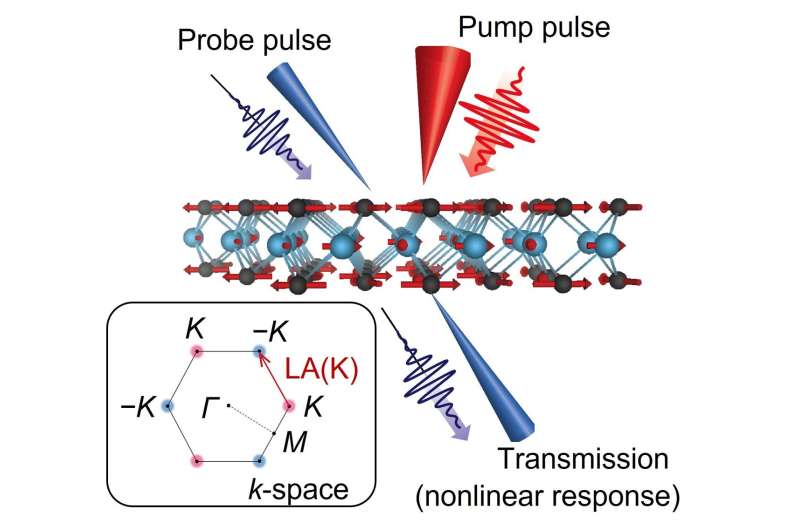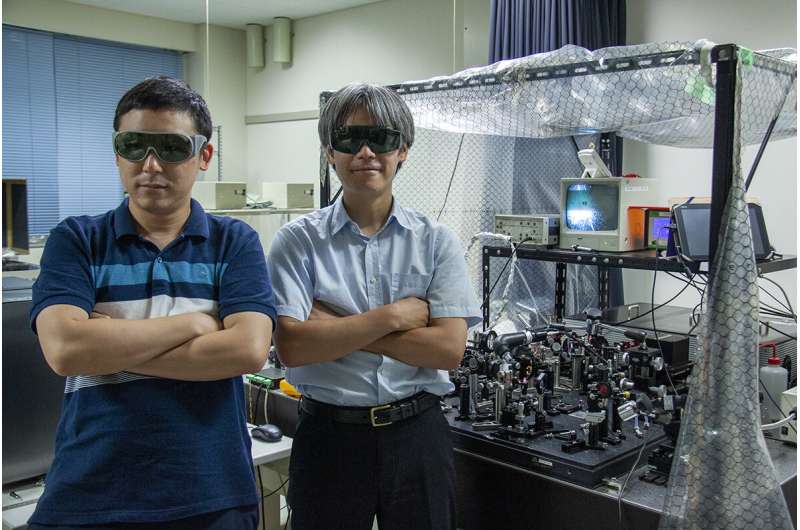Researchers reveal origin of ultrafast mystery signals in valleytronic materials

Tiny materials hold big mysteries, the solutions to which could bring about next-generation electronics. An international collaboration led by researchers based in Japan has solved the whodunit of cryptic overtone signals in an analysis of molybdenum diselenide, an atomically thin crystal lattice with desirable properties unique from its bulkier three-dimensional form.
They published their results on July 25 in Nature Communications.
The compound belongs to a family of similarly two-dimensional semiconductors called transitional metal dichalcogenide (TMD) monolayers, all of which have electronic band structures containing so-called valleys. TMD lattices are organized as hexagons, with the corresponding wavevector, known as k-space, along the side. The side center point of the k-space is known as the "M point" and the six corners as "K (-K) points."
The valleys are the dips and rises of the electronic band at the corners of the hexagons, where energy or information-carrying particles can move to tip the material to action. The intervalley activities, especially as related to electron scattering, have remained elusive, though. In this process, phonons, or units of energy manifested as vibrations, cause the electrons to disperse and transition states in the intervalley space at ultrafast speed.
This valley polarization, if it can be controlled to induce or reduce specific properties, makes TMDs the most promising candidate for advanced technologies, according to co-corresponding author Soungmin Bae, postdoctoral researcher in the Laboratory for Materials and Structures, Tokyo Institute of Technology. The combination of valley and the potential for electronics informs the name of this niche field: valleytronics.
"To establish the fundamental understanding of ultrafast dynamics associated with phonon-mediated intervalley scattering processes, we performed pump-probe spectroscopy using sub-10-femtosecond—10-quadrillionth of a second—ultrashort pulsed lasers and found interesting overtone signals of acoustic phonons in the optical modulation," Bae said. "The signals were already well-known in the TMDs community, but the origin was unclear, so our original question we aimed to answer was, 'why do we observe such overtone signals?'"
Pump-probe spectroscopy involves irradiating a sample of the TMD with an ultrashort laser pulse in two parts. The pump is a strong beam that excites the TMD, causing the system to oscillate, like throwing a stone in a pond to produce concentric waves. The probe is a weaker beam that tracks the temporal evolution of the induced oscillations—the waves of the lattice vibrations, also known as phonons—via changes in certain optical constants of the system, such as its amount of absorption and reflection.

The researchers saw several signals, visualized as optical modulations, at both even and odd orders of phonon oscillations from the monolayer TMD. They analyzed the symmetry of the phonons and used first-principles calculations—or supercomputer-powered assessments that describe the quantum mechanical state and dynamics of every nucleus and electron in the system, from which details of specific components can be extracted—to reveal that only the longitudinal acoustic phonon at the K point could produce the observed odd-order signal since it modulated the laser light asymmetrically, compared to the M-point phonon's symmetric reflection, which only produces even overtones.
"K-point longitudinal acoustic phonons are responsible for ultrafast intervalley scattering in monolayer molybdenum diselenide," said co-corresponding author Jun Takeda, professor in Yokohama National University's Graduate School of Engineering Science. "Normally K-point phonons could not modulate the optical properties because of the large mismatch between the wavevector—the direction and magnitude—of the incident light and that of the phonons."
Takeda said that, in TMDs, however, the high symmetry of the two-dimensional crystal lattice allows the K-point acoustic phonons to modulate the optical response and to generate signals at multiple frequencies.
"This work proves the importance of combined approach of ultrafast spectroscopy with symmetry analysis and first-principles calculations for unveiling the underlying physics of intervalley scattering process in valleytronic materials," said co-corresponding author Ikufumi Katayama, professor in Yokohama National University's Graduate School of Engineering Science.
"Next, we would like to extend these approaches to other exotic two-dimensional material systems for future electronic and valleytronic applications and to establish ways to manipulate the optical and physical properties at ultrafast timescales."
More information: Soungmin Bae et al, K-point longitudinal acoustic phonons are responsible for ultrafast intervalley scattering in monolayer MoSe2, Nature Communications (2022). DOI: 10.1038/s41467-022-32008-6
Journal information: Nature Communications
Provided by Yokohama National University




















